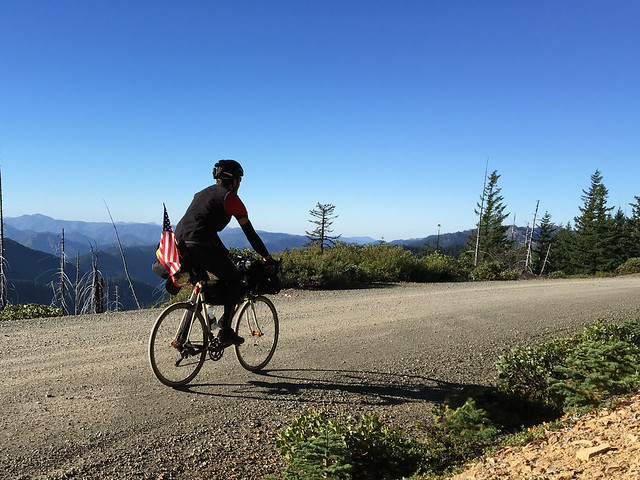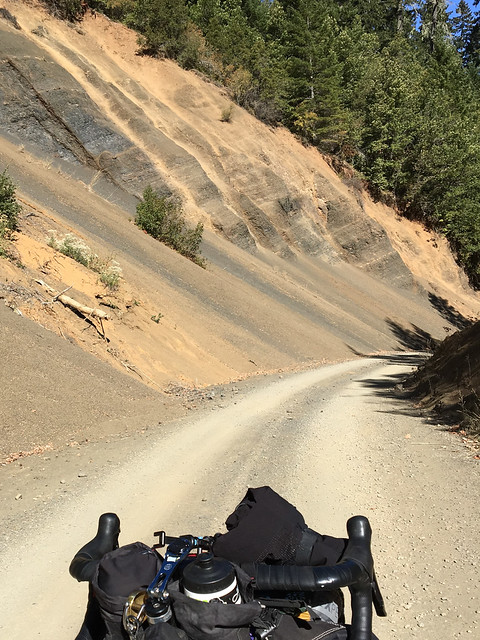
(Photos: J. Maus/BikePortland)
Cycle Oregon 29 is in the books. It happened last week and now there are 2,000 or so people sitting at work with souvenirs, sore legs, and constant questioning from co-workers who ask, “You did what?! Why?!”.
I missed the first two days of the ride this year due to a family event in California over the weekend. One the negative side, that meant I didn’t get to ride into Camas Valley or do the (now legendary) climb and descent out of it on Day Two. But on the positive side, it meant that I could do a little pre-ride adventure on my own in the rugged Rogue River – Siskiyou National Forest.
Over the course of the week riders were treated to the many charms southern Oregon’s physical, historical, and modern landscape: a gorgeous coastline, towering trees, wild rivers, and bucolic farms; tales of native tribes and gold discoveries; and rural residents whose lives are simultaneously simple and often misunderstood by us cityfolk. The theme of the ride, “Go for the Gold!,” harkened back to hard-luck times when settlers sought fortunes in the riverbeds. Today, many of the people who’ve settled in the towns we camped in and rode through are still working hard and hoping to strike it rich — likely without the boundless optimism pioneers once had.
Cycle Oregon founder Jonathan Nicholas captured this urban-rural tension during remarks he shared to a rapt audience that sat in a grassy field under a full moon in Glendale on the final night of the ride. He spoke about the common bonds we all share as Oregonians and the urgent need to find balance in today’s hyper-polarized civic dialogue.
Bear Camp backroads
The high point (literally and figuratively) of my Cycle Oregon week was Bear Camp Road, a (mostly) paved route that reaches about 4,800 feet up into the Rogue River-Siskiyou National Forest. Last month I rode up its western flank for the first time, following the same route we did on Cycle Oregon last week. On Monday night I tackled its eastern flank when I rode from Interstate 5 at Merlin (where my family dropped me off on their way home to Portland from California) up to a campsite near Bear Camp Lookout. I didn’t get on my bike until about 5:30 pm so I ended up finishing the tough climb after dark. It was about 9:30 pm by the time I found the rustic campsite (it was off a rough dirt road with no signage or anything) and set out my sleeping bag.
After a quiet night alone in the forest (what a treat!), I planned to meet up with Cycle Oregon on the coast in Gold Beach where they’d end up after their overnight in Bandon. Instead of taking Bear Camp Road down off the mountain, I opted instead for a dirt/gravel option called Burnt Ridge Road. It was about 22 miles between my camp at the top and where it came out on the Rogue River in Agness. I highly recommend this as an alternate. The road is in great shape (as long as you don’t mind gravel and dirt), you’ll have complete solitude, and the views along the ridge are wonderful.
Two days later I got yet another chance to do some exploring off Bear Camp Road. After lunch at the summit, I descended down on the official route for about 10 miles. Then I peeled off on a more interesting road that I’d been researching on my maps: Peavine Road/Serpentine Spring Road. It’s narrow, twisty, and has rather large chip seal but is otherwise in great condition. It added about 4 miles and another 800 feet or so of (very steep) climbing, but it was well worth it. In 14 miles I didn’t hear or see any other person or vehicle. It was one of the most fun and remote paved roads I’ve ever ridden. Definitely recommend this next time you are in the area.
Advertisement
A side trip to the Old Agness Store
Before heading into Gold Beach I decided to take another detour to the Old Agness Store. It’s about 12 miles out-of-the way down a dead-end road so it’s not a place everyone opts to explore. In fact, the local motto is, “The best wrong turn you’ll ever make!” And now I can say it’s true! The road to get out there is like a roller-coaster ride without the queasiness — perfectly smooth and windy with grand views of the Rogue River.
The store itself is everything a modern-day adventurer could hope for. Recently renovated by Steve and Michele Berlant, a couple who met at the store in 2008, it now offers local gifts, home-baked bread, fresh soups, smoothies, and much more. I ordered the garden salad and sat on outside on the porch to chat with a couple on a motorcycle trip who I’d met along the road. The salad was fantastic and it turned out that Steve picked everything in it (except the carrots) from the store’s garden out back. Whether you’re hungry for food, souvenirs, or just some local hospitality, you owe it to yourself to stop at the Old Agness Store next time you’re in the area.
Following a trail of gold

True story: On my drive south to California with the family before I met up with Cycle Oregon we met a gold miner. Seriously: A real-life, modern person who wakes up and looks for gold. We were at a gas station in Grants Pass (where my dad works part-time) when an elderly fellow in a beat-up pick-up rolled up. He had that look — dirty, worn-out jeans, long and uncut white hair and beard, callused and dingy hands — that always piques my curiousity. We were chatting with him for a bit when he pulled a huge gold nugget out of his pocket. He explained that he’d been mining gold in the “850 or so creeks” in the nearby hills since 1974. He’d been carrying that nugget (which he said was worth about $20,000) in his pocket for about 40 years.
Little did I know that the following week I’d be riding along roads full of historic mining claims and nearby rivers with a rich history of gold-seekers and industrial mining. From the wars over gold deposits between natives and white settlers at Gold Beach to the mining camps along the Rogue River near Indian Mary Park and the many claims that still exist along Cow Creek, we probably rode by millions of dollars in pure gold.
Onward to 30!

Next year Cycle Oregon turns 30 years old. That’s an important and impressive milestone that will bring with it another amazing ride and probably some soul-searching from the organization’s board and staff. The Week Ride has become a respected institution, but all institutions must re-invent themselves to stay relevant. How and if Cycle Oregon makes substantive changes to its Week Ride after next year is anyone’s guess. I’d personally love to see more adventurous (even dirt and gravel) routes offered as options — sort of a more formal extension of the “Exploregon” rides I’ve been doing.
Regardless of what happens, the organization’s mission will remain. The nearly 3,000 riders, staff, and volunteers that make up the Week Ride is an economic bright spot to the towns it rolls through. The nonprofit not only dishes out cash for its hosts it also makes them eligible for project grants through its charitable fund. Of course bicycling isn’t a cure-all for Oregon’s rural economies; but the perspectives gained by people on both sides of the handlebars are a solid start.
See excellent photos of the the 2016 ride on the Cycle Oregon Facebook page.
— Jonathan Maus, (503) 706-8804 – jonathan@bikeportland.org
BikePortland is supported by the community (that means you!). Please become a subscriber or make a donation today.



















